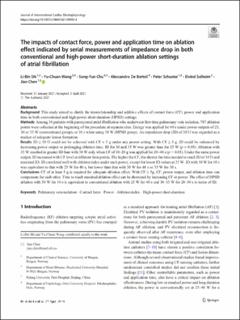| dc.contributor.author | Shi, Libin | |
| dc.contributor.author | Wang, Yu-Chuan | |
| dc.contributor.author | Chu, Songyun | |
| dc.contributor.author | Bortoli, Alessandro De | |
| dc.contributor.author | Schuster, Peter Moritz | |
| dc.contributor.author | Solheim, Eivind | |
| dc.contributor.author | Chen, Jian | |
| dc.date.accessioned | 2022-01-27T10:04:03Z | |
| dc.date.available | 2022-01-27T10:04:03Z | |
| dc.date.created | 2021-09-08T12:26:10Z | |
| dc.date.issued | 2021 | |
| dc.identifier.issn | 1383-875X | |
| dc.identifier.uri | https://hdl.handle.net/11250/2881908 | |
| dc.description.abstract | Background: This study aimed to clarify the interrelationship and additive effects of contact force (CF), power and application time in both conventional and high-power short-duration (HPSD) settings.
Methods: Among 38 patients with paroxysmal atrial fibrillation who underwent first-time pulmonary vein isolation, 787 ablation points were collected at the beginning of the procedure at separate sites. Energy was applied for 60 s under power outputs of 25, 30 or 35 W (conventional group), or 10 s when using 50 W (HPSD group). An impedance drop (ID) of 10 Ω was regarded as a marker of adequate lesion formation.
Results: ID ≥ 10 Ω could not be achieved with CF < 5 g under any power setting. With CF ≥ 5 g, ID could be enhanced by increasing power output or prolonging ablation time. ID for 30 and 35 W was greater than for 25 W (p < 0.05). Ablation with 35 W resulted in greater ID than with 30 W only when CF of 10–20 g was applied for 20–40 s (p < 0.05). Under the same power output, ID increased with CF level at different time points. The higher the CF, the shorter the time needed to reach ID of 10 Ω and maximal ID. ID correlated well with ablation index under each power, except for lower ID values at 25 W. ID with 50 W for 10 s was equivalent to that with 25 W for 40 s, but lower than that with 30 W for 40 s or 35 W for 30 s.
Conclusions: CF of at least 5 g is required for adequate ablation effect. With CF ≥ 5g, CF, power output, and ablation time can compensate for each other. Time to reach maximal ablation effect can be shortened by increasing CF or power. The effect of HPSD ablation with 50 W for 10 s is equivalent to conventional ablation with 25 W for 40 s and 30–35 W for 20–30 s in terms of ID. | en_US |
| dc.language.iso | eng | en_US |
| dc.publisher | Springer | en_US |
| dc.rights | Navngivelse 4.0 Internasjonal | * |
| dc.rights.uri | http://creativecommons.org/licenses/by/4.0/deed.no | * |
| dc.title | The impacts of contact force, power and application time on ablation effect indicated by serial measurements of impedance drop in both conventional and high-power short-duration ablation settings of atrial fibrillation | en_US |
| dc.type | Journal article | en_US |
| dc.type | Peer reviewed | en_US |
| dc.description.version | publishedVersion | en_US |
| dc.rights.holder | Copyright 2021 the authors | en_US |
| cristin.ispublished | true | |
| cristin.fulltext | original | |
| cristin.qualitycode | 1 | |
| dc.identifier.doi | 10.1007/s10840-021-00990-4 | |
| dc.identifier.cristin | 1932423 | |
| dc.source.journal | Journal of interventional cardiac electrophysiology | en_US |
| dc.identifier.citation | Journal of interventional cardiac electrophysiology. 2021. | en_US |

